Monarchies in Europe

In the European history, monarchy was the prevalent form of government throughout the Middle Ages, only occasionally competing with communalism, notably in the case of the maritime republics and the Swiss Confederacy.
In the
The monarchies can be divided into two broad classes: premodern states and those that gained their independence during or immediately after the Napoleonic Wars. Denmark, Norway, Sweden, the UK, Spain, and Andorra are the successors to premodern monarchies. Liechtenstein, the Netherlands, Belgium, and Luxembourg were established or gained independence through various methods during the Napoleonic Wars. The State of the Vatican City was recognized as a sovereign state administered by the Holy See in 1929.
Ten of these monarchies are
Most of the monarchies in Europe are
At the start of the 20th century, France, Switzerland and San Marino were the only European nations to have a republican form of government. The ascent of republicanism to the political mainstream started only at the beginning of the 20th century, facilitated by the toppling of various European monarchies after the end of World War I; as at the beginning of the 21st century, most of the states in Europe are republics with either a directly or indirectly elected head of state. The latest European state to abolish monarchy was the State of Malta which became a republic in December 1974.
History
Origins
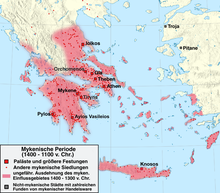
The notion of kingship in Europe ultimately originates in systems of
Archaic and classical antiquity
Since the beginning of

The dominant poleis of
Roman Empire and legacy
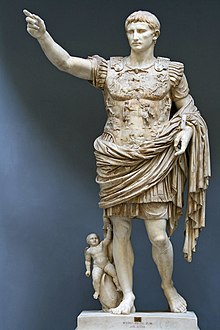
Caesar's adoptive son Octavian prevailed in the ensuing civil war, and converted the Roman Republic into the
Medieval Europe
The monarchies of Europe in the Christian Middle Ages derived their claim from Christianisation and the divine right of kings, partly influenced by the notion of sacral kingship inherited from Germanic antiquity.[citation needed] The great powers of Europe in the Early modern period were the result of a gradual process of centralization of power taking place over the course of the Middle Ages.[citation needed]
The Early Middle Ages begin with a fragmentation of the former Western Roman Empire into "barbarian kingdoms".[citation needed] In Western Europe, the kingdom of the Franks developed into the Carolingian Empire by the 8th century, and the kingdoms of Anglo-Saxon England were unified into the kingdom of England by the 10th century.[citation needed]
With the breakup of the Carolingian Empire in the 9th century, the system of feudalism places kings at the head of a pyramid of relationships between liege lords and vassals, dependent on the regional rule of barons, and the intermediate positions of counts (or earls) and dukes.[citation needed] The core of European feudal manorialism in the High Middle Ages were the territories of the kingdom of France, the Holy Roman Empire (centered on the nominal kingdoms of Germany and Italy) and the kingdoms of England and Scotland.[citation needed]
Early Modern Europe

With the rise of nation-states and the
- the Kingdom of France with its colonial empire
- the Portuguese Empire of the Kingdom of Portugal (personal union with Spain 1580–1640)
- the Bourbon Spain)
- the British Empire of the English and Scottish Union of the Crowns (after 1707 the Kingdom of Great Britain)
- the Holy Roman Empire was effectively dominated by the Habsburg monarchy and later by an emerging Prussia
- the Tsardom of Russia
- the Crown of the Kingdom of Poland as the Polish–Lithuanian Commonwealth
- the kingdom of Sweden rose to the status of great power as the comparatively short-lived Swedish Empire due to the Thirty Years' War
- the kingdom of Denmark-Norway
The House of Habsburg became the most influential royal dynasty in continental Europe by the 17th century, divided into the Spanish and Austrian branches.[citation needed]
Modern Europe
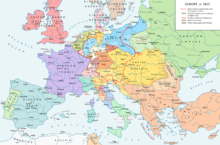

The modern resurgence of parliamentarism and anti-monarchism began with the
Following Napoleon's defeat in 1814 and 1815, the reactionary Congress of Vienna determined that all of Europe should consist of strong monarchies (with the exception of Switzerland and a few insignificant republics). In France, the Bourbon dynasty was restored, replaced by the liberal July Monarchy in 1830, before the entire monarchy was again abolished during the Revolutions of 1848. The popular Napoleon III was able to proclaim himself Emperor in 1852, thus founding the Second French Empire.[citation needed]
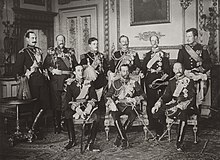
The kingdoms of Sicily and Naples ("Two Sicilies") were absorbed into the Kingdom of Sardinia to form the Kingdom of Italy in 1861. Austria and Prussia vied to unite all German states under their banner, with Prussia emerging victorious in 1866. It succeeded in provoking Napoleon III to declare war, leading to the defeat of France, and the absorption of the southern German states into the German Empire in the process (1870–71). From the ashes of the Second Empire rose the French Third Republic, the only great republican European power until World War I.[citation needed]
Much of 19th century politics was characterised by the division between
] The Kingdom of Spain was briefly abolished in 1873, restored 1874–1931 and again in 1975 (or in 1947). The Kingdom of Portugal was abolished in 1910. The Russian Empire ended in 1917, the Kingdom of Prussia in 1918. TheThe Napoleonic Wars transformed the political landscape of Europe, and a number of modern kingdoms were formed in a resurgence of monarchism after the dissolution of the Holy Roman Empire and the defeat of the French Empire:
 the Austrian Empire and
the Austrian Empire and  Austria-Hungary (1804–1918)
Austria-Hungary (1804–1918) the Kingdom of Württemberg (1805–1918)
the Kingdom of Württemberg (1805–1918) the Kingdom of Bavaria (1805–1918)
the Kingdom of Bavaria (1805–1918) the Kingdom of Saxony (1806–1918)
the Kingdom of Saxony (1806–1918) the Kingdom of the Two Sicilies (1808–1861)
the Kingdom of the Two Sicilies (1808–1861) the Kingdom of the Netherlands (1813/15 to present)
the Kingdom of the Netherlands (1813/15 to present)- Kingdom of Norway(1814 to present)
 the Kingdom of France ("Bourbon Restoration")
the Kingdom of France ("Bourbon Restoration")  (1814–1830) followed by
(1814–1830) followed by  the July Monarchy (Kingdom of France) (1830–1848)
the July Monarchy (Kingdom of France) (1830–1848) the Kingdom of Hanover (1814–1866)
the Kingdom of Hanover (1814–1866) the Kingdom of Poland (1815–1867)
the Kingdom of Poland (1815–1867)- Kingdom of Belgium(1830 to present)
 the Kingdom of Greece (1832–1924 & 1935–1973)
the Kingdom of Greece (1832–1924 & 1935–1973) the Second French Empire (1852–1870)
the Second French Empire (1852–1870) the Principality of Montenegro (1852–1910) continued as
the Principality of Montenegro (1852–1910) continued as  the Kingdom of Montenegro (1910–1918)
the Kingdom of Montenegro (1910–1918) the Kingdom of Italy (1861–1946)
the Kingdom of Italy (1861–1946)- Principality of Romania (1862–1881) continued as the Kingdom of Romania(1882–1947)
 the German Empire (1871–1918)
the German Empire (1871–1918) the Principality of Bulgaria (1878–1908) continued as the Kingdom of Bulgaria (1908–1946)
the Principality of Bulgaria (1878–1908) continued as the Kingdom of Bulgaria (1908–1946) the Principality of Serbia (1815–1882) continued as
the Principality of Serbia (1815–1882) continued as  the Kingdom of Serbia (1882–1918)
the Kingdom of Serbia (1882–1918) the Principality of Albania (1914–1925)
the Principality of Albania (1914–1925)
Many countries
New monarchies

A few new monarchies emerged for a brief period of time in the final years of World War I:[citation needed]
 the Kingdom of Finland (1918–1919)
the Kingdom of Finland (1918–1919) the Kingdom of Lithuania (1918)
the Kingdom of Lithuania (1918) the Kingdom of Poland (1917–1918)
the Kingdom of Poland (1917–1918) the Hetmanate) (1918)
the Hetmanate) (1918) the United Baltic Duchy (1918)
the United Baltic Duchy (1918)
Monarchies established or re-established during the
 the Kingdom of Iceland (1918–1944)
the Kingdom of Iceland (1918–1944) the Kingdom of Yugoslavia (1918–1945)
the Kingdom of Yugoslavia (1918–1945)- Kingdom of Hungary(1920–1946)
 the Irish Free State (1922–1937)
the Irish Free State (1922–1937)- Kingdom of Albania(1928–1944)
 the Vatican City State governed by the Holy See (1929 to present)
the Vatican City State governed by the Holy See (1929 to present) the Kingdom of Greece (1935–1973)
the Kingdom of Greece (1935–1973)
Monarchies established or re-established from 1940 and onwards:[citation needed]
 the Kingdom of Croatia (1941–1943)
the Kingdom of Croatia (1941–1943)- Kingdom of Spain(1947 to present)
 the Kingdom of Malta (State of Malta) (1964–1974)
the Kingdom of Malta (State of Malta) (1964–1974)
Territorial evolution

|

|
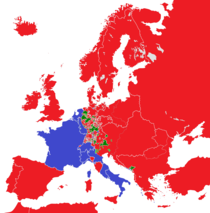
|

|
| European states in 1714 | European states in 1789 | European states in 1799 | European states in 1815
|
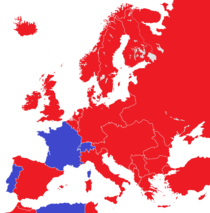
|

|

|

|
European states in 1914
|
European states in 1930
|
European states in 1950
|
European states in 2015
|
Current monarchies
There are currently twelve monarchies in Europe. Eleven of these are constitutional monarchies while one (the
Table of monarchies in Europe
| State | Type | Succession | Dynasty | Title | Monarch | Reigning since
|
First in line | |
|---|---|---|---|---|---|---|---|---|
Principality of Andorra
|
Constitutional | Ex officio
|
Bishop of Urgel
|
Co-prince | 
|
Joan Enric Vives i Sicília | 12 May 2003 | None; appointed by the Pope |
| President of France | 
|
Emmanuel Macron | 14 May 2017 | None; successor elected in the next French presidential election
| ||||
Kingdom of Belgium
|
Constitutional | Hereditary
|
Belgium
|
King | 
|
Philippe | 21 July 2013 | Heir apparent: Princess Elisabeth, Duchess of Brabant (eldest child) |
Kingdom of Denmark
|
Constitutional | Hereditary | Glücksburg | King | 
|
Frederik X | 14 January 2024 | Heir apparent: Christian, Crown Prince of Denmark (eldest child) |
Principality of Liechtenstein
|
Constitutional | Hereditary
|
Liechtenstein | Sovereign Prince | 
|
Hans-Adam II | 13 November 1989 | Heir apparent: Hereditary Prince Alois (eldest son) |
Grand Duchy of Luxembourg
|
Constitutional | Hereditary | Nassau-Weilburg (Bourbon-Parma) | Grand Duke | 
|
Henri | 7 October 2000 | Heir apparent: Hereditary Grand Duke Guillaume (eldest child) |
Principality of Monaco
|
Constitutional | Hereditary
|
Grimaldi | Sovereign Prince | 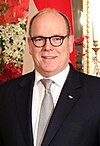
|
Albert II | 6 April 2005 | Heir apparent: Hereditary Prince Jacques (only legitimate son) |
| Kingdom of the Netherlands | Constitutional | Hereditary
|
Amsberg )
|
King | 
|
Willem-Alexander | 30 April 2013 | Heir apparent: Princess Catharina-Amalia, Princess of Orange (eldest child) |
Kingdom of Norway
|
Constitutional | Hereditary
|
Glücksburg | King | 
|
Harald V
|
17 January 1991 | Heir apparent: Crown Prince Haakon (only son) |
Kingdom of Spain
|
Constitutional | Hereditary
|
Bourbon | King | 
|
Felipe VI | 19 June 2014 | Heir presumptive: Leonor, Princess of Asturias (elder daughter)[a] |
Kingdom of Sweden
|
Constitutional | Hereditary
|
Bernadotte | King | 
|
Carl XVI Gustaf | 15 September 1973 | Heir apparent: Crown Princess Victoria (eldest child) |
| United Kingdom of Great Britain and Northern Ireland | Constitutional | Hereditary | Windsor (Mountbatten) | King | 
|
Charles III[b] | 8 September 2022 | Heir apparent: William, Prince of Wales (eldest child) |
Vatican City State
|
Absolute | Elective | — | Pope | 
|
Francis | 13 March 2013 | Elective |
Descriptions
Andorra
Belgium
Belgium has been a kingdom since 21 July 1831 without interruption, after it became independent from the United Kingdom of the Netherlands with Leopold I as its first king. While in a referendum held on 12 March 1950, 57.68 per cent of the Belgians voted in favour of allowing Leopold III, whose conduct during World War II had been considered questionable and who had been accused of treason, to return to the throne; due to civil unrest, he opted to abdicate in favour of his son Baudouin on 16 July 1951.[13] The current monarch is Philippe.
Denmark
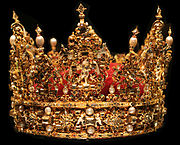
In Denmark, the monarchy goes back to the legendary kings before the 10th century and the Danish monarchy is the oldest in Europe (with the first attested historical king being Ongendus around the year 710). Currently, about 80 per cent support keeping the monarchy.[14] The current monarch is Frederik X. The Danish monarchy also includes the Faroe Islands and Greenland which are parts of the Kingdom of Denmark with internal home rule. Due to this status, the monarch has no separate title for these regions. On his accession he assumed the title and style "His Majesty King Frederik X".
Liechtenstein
Luxembourg
Monaco
Netherlands
Though while not using the
His descendants became de facto heads of state of the Dutch Republic during the 16th to 18th centuries, which was an effectively hereditary role. For the last half century of its existence, it became an officially hereditary role and thus a monarchy (though maintaining republican pretense) under Prince William IV. His son, Prince William V, was the last stadtholder of the republic, whose own son, King William I, became the first king of the United Kingdom of the Netherlands, which was established on 16 March 1815 after the Napoleonic Wars. With the independence of Belgium on 21 July 1831, the Netherlands formally became the Kingdom of the Netherlands. The current monarch is Willem-Alexander.
Norway
Spain
Spain came into existence as a single, united kingdom under
Data from 2006 suggested that only 25 per cent of Spaniards were in favour of establishing a republic;[21] however, the numbers have increased since Juan Carlos I abdicated.[22]
Sweden
United Kingdom
The monarchy of the United Kingdom can be defined to have started either with the
Support for establishing a republic instead of a monarchy was around 18 percent in the United Kingdom in 2006, while a majority thinks that there will still be a monarchy in the United Kingdom in ten years' time, public opinion is rather uncertain about a monarchy still existing in fifty years and a clear majority believes that the monarchy will no longer exist a century after the poll.[23] Public opinion is, however, certain that the monarchy will still exist in thirty years.
The monarch of the United Kingdom is also the monarch of the 14 other Commonwealth realms, none of which are in Europe. Some of these realms have significant levels of support for republicanism.[24]
Vatican City
Differently from the
Succession laws
The
There are plans to change to absolute primogeniture in Spain[27] through a rather complicated process, as the change entails a constitutional amendment. Two successive parliaments will have to pass the law by a two-thirds majority and then put it to a referendum. As parliament has to be dissolved and new elections have to be called after the constitutional amendment is passed for the first time, then Prime Minister of Spain José Luis Rodríguez Zapatero indicated he would wait until the end of his first term in 2008 before passing the law,[28] although this deadline passed without the referendum being called. The amendment enjoys strong public support.[29]
To change the order of
Liechtenstein uses agnatic primogeniture (aka Salic law), which completely excludes women from the order of succession. It was criticised for this by a United Nations committee for this perceived gender equality issue in November 2007.[30]
Luxembourg also used agnatic primogeniture until 20 June 2011, when absolute primogeniture was introduced.[31]
The co-princes of
The absolute monarch of Vatican City, the pope, is elected by the College of Cardinals. The current ruler is Pope Francis.
Costs
One issue that occasionally rises is whether the monarchies are too expensive when compared to republics, or whether particular monarchies are more expensive than others, to maintain. This comparison may be hard to draw, since financial administration may differ radically from country to country, and not all profits and costs are publicly known, and because of different arrangements regarding the
In 2016, Dutch newspaper de Volkskrant published an overview of the annual expenditure (excluding security expenses) of all European royal houses (not counting Luxembourg and the four monarchical European microstates).
| Country | Annual costs (royal house) |
Annual salary (monarch) |
Does monarch pay taxes? | Annual costs (royal house, per taxpayer) |
|---|---|---|---|---|
| €36 million | €11.5 million | Yes | €3.15 | |
| €13 million | €10 million | Only inheritance tax and property tax | €2.30 | |
| €41 million | €0.9 million | No | €2.40 | |
| €51 million | €1.2 million | No | €9.70 | |
| €8 million | €0.2 million | Yes | €0.16 | |
| €13 million | €6.7 million | Yes | €1.30 | |
| €45 million | €15.6 million | Yes (to himself) | €0.70 |
Source: de Volkskrant (2016), based on the royal houses' websites of the seven monarchies, professor Herman Matthijs' 2013 study,[32] the Dutch National Budget 2017, and ABCTOPConsult.[33]
In 2013, professor Herman Matthijs from Ghent University calculated the costs of the seven EU monarchies plus Norway, and compared them to the EU's two most populous republics, France and Germany. His four main conclusions were:
- The personal salaries of presidents are lower than those of monarchs;[32]
- The transparency differs between republics and monarchies, and is formally regulated in republics;
- In republics, pension costs of former heads of state are higher, although the figures don't say so;
- The existence of subsidies to family members of the heads of state in some monarchies increases their expenses.
He stressed that the financial administration's transparency differs enormously between countries; especially the non-transparent monarchies may be much more expensive than is publicly known. This means comparing them to republics, especially the very transparent administration of France where citizens can know exactly what they pay for, may be unfair. In a 2015 interview with NRC Handelsblad, Matthijs commented that the then-known €7.7 million allotted to the royal house in Spain's national budget was 'unbelievable': "I can't find out more, but I understand from the media that the total expenses of the Spanish house may be as much as 80 million."[34]
| Country | Form of government | Official annual costs | Transparency |
|---|---|---|---|
| Monarchy | €13.9 million | Not transparent | |
| Monarchy | €13.2 million | Not transparent | |
| Republic | €106.2 million | Very transparent | |
| Republic | €25.6 million | Relatively transparent | |
| Monarchy | €9.3 million | Not transparent | |
| Monarchy | €39.9 million | Relatively transparent | |
| Monarchy | €42.7 million | Relatively transparent | |
| Monarchy | €7.9 million | Not transparent | |
| Monarchy | €15.1 million | Not transparent | |
| Monarchy | €38.0 million | Poorly transparent | |
| Source: Herman Matthijs, "De kosten van een staatshoofd in West-Europa" (2013).[32] | |||
Calls for abolition
Calls for the abolition of Europe's monarchies were widespread since the development of
In subsequent decades, republicanism would regain lost ground with the rise of liberalism, nationalism, and later socialism. The Revolutions of 1848 were largely inspired by republicanism. Most of Europe's monarchies were abolished either during or following World War I or World War II, and the remaining monarchies were transformed into constitutional monarchies.
Republican movements in Europe remain active up to present, though their political clout is limited in most European monarchies. The most prominent organisations campaigning to eliminate one or more of Europe's remaining monarchies and/or to liquidate assets reserved for reigning families are affiliated with the Alliance of European Republican Movements, but there are smaller independent initiatives as well, such as Hetis2013 in the Netherlands.[35][36] Also, some political parties (e.g. Podemos in Spain) have stepped up and called for national referendums to abolish monarchies.[37][38]
Calls for restoration
The political influence of monarchism in former European monarchies is very limited.
There are several monarchist parties in France, most notably the Action Française (established 1899) and Alliance Royale (established 2001). Monarchist parties also exist
(2012).Otto von Habsburg renounced all pretense to the Habsburg titles in 1958, and monarchism in Austria has next to no political influence; a German monarchist organisation called Tradition und Leben has been in existence since 1959. Monarchism in Bavaria has had more significant support, including Franz Josef Strauss, minister-president of Bavaria from 1978 to 1988.
According to a 2007 opinion poll conducted at the request of the Romanian royal family, only 14% of Romanians were in favour of the restoration of the monarchy.[45] Another 2008 poll found that only 16% of Romanians are monarchists.[46] In December 2017, on the backdrop of the increased capital of trust in the Royal House of Romania, re-emerging with the death of King Michael, the executive chairman of the ruling Social Democratic Party Nicolae Bădălau said that one could organize a referendum on the transition to the monarchical ruling form, arguing that "it is not a bad thing, considering that the countries that have the monarchs are developed countries", being a project of the future.[47]
See also
- List of European Union member states by political system
- List of current monarchies
- List of monarchies
- List of dynasties
- Abolition of monarchy
- List of political systems in France
- Monarchies in the Americas
- Monarchies in Oceania
- Monarchies in Africa
- Monarchies in Asia
Notes
- ^ Leonor is, as the reigning king's older daughter, the current heiress presumptive. Felipe VI has no sons.
- ^ The monarch of the United Kingdom is also the sovereign of the fourteen other Commonwealth realms.
References
- ^ a b De Blois & Van der Spek (2004), p. 71–72.
- ^ De Blois & Van der Spek (2004), p. 74.
- ^ De Blois & Van der Spek (2004), p. 86–87.
- ^ Encarta-encyclopedie Winkler Prins (1993–2002) s.v. "geronten".
- ^ Encarta-encyclopedie Winkler Prins (1993–2002) s.v. "Romeinse Rijk. § 2. Staatsinstellingen".
- ^ De Blois & Van der Spek (2004), p. 103–106.
- ^ Encarta-encyclopedie Winkler Prins (1993–2002) s.v. "hellenisme".
- ^ a b De Blois & Van der Spek (2004), p. 127.
- ^ Encarta-encyclopedie Winkler Prins (1993–2002) s.v. "Carthago. § 1. Geschiedenis".
- ^ Encarta-encyclopedie Winkler Prins (1993–2002) s.v. "Diocletianus, Gaius Aurelius Valerius."
- ^ Henri Pirenne, Mohammed and Charlemagne (1937), 46–48.
- ^ United States Department of State – Under Secretary of State for Public Diplomacy and Public Affairs – Bureau of Public Affairs. "Background Note: Andorra". Retrieved 12 September 2009.
- ^ european navigator (20 June 2006). "Full list of the results of the referendum on the issue of the monarchy (13 March 1950)". Historical events – 1945–1949 The pioneering phase. Retrieved 28 June 2006.
- ^ "Republicans plan to cut Mary's reign". The Age. Australia. 12 May 2004. Retrieved 27 June 2006.
- ^ United States Department of State – Under Secretary of State for Public Diplomacy and Public Affairs – Bureau of Public Affairs. "Background Note: Liechtenstein". Retrieved 12 September 2009.
- Foreign and Commonwealth Office. "Country Profile: Liechtenstein". Archived from the originalon 25 May 2011. Retrieved 25 November 2009.
- ^ Fayot, Ben (October 2005). "Les quartres référendums du Grand-Duché de Luxembourg" (PDF) (in French). Luxembourg Socialist Workers' Party. Archived from the original (PDF) on 27 September 2007. Retrieved 3 August 2007.
- ^ United States Department of State – Under Secretary of State for Public Diplomacy and Public Affairs – Bureau of Public Affairs. "Background Note: Monaco". Retrieved 12 September 2009.
- ^ Berglund, Nina (5 November 2005). "Monarchy losing support". Aftenposten. Archived from the original on 29 May 2006. Retrieved 4 April 2007.
- ^ Título II. De la Corona, Wikisource. Constitution of Spain 1978, Title II, Article 56, Subsection 2 and amended by Royal Decree 1368/1987, dated 6 November
- Angus Reid Global Monitor: Polls & Research. Archived from the originalon 28 June 2013. Retrieved 14 April 2013.
- ^ Douwe Keulen, Jan (5 June 2014). "The call for a third Spanish republic". Al Jazeera. Retrieved 16 July 2014.
- ^ Ipsos MORI (22 April 2006). "Monarchy Trends". Retrieved 27 June 2006.
- ^ "Where the queen still rules". The Guardian. UK. 7 November 1999. Retrieved 30 June 2006.
- ^ United States Department of State – Under Secretary of State for Public Diplomacy and Public Affairs – Bureau of Public Affairs. "Background Note: Holy See". Retrieved 12 September 2009.
- ^ "Overturning centuries of royal rules". BBC. 28 October 2011. Retrieved 29 March 2018.
- ^ Fordham, Alive (8 November 2005). "War of Spanish succession looms while baby sleeps". The Times. UK. Retrieved 29 June 2006.
- ^ Tarvainen, Sinikka (26 September 2006). "Royal pregnancy poses political dilemma for Spain". Monsters and Critics. Archived from the original on 14 December 2011. Retrieved 27 September 2006.
- ^ Angus Reid (21 October 2006). "Spaniards Support Monarchy Amendment". Angus Reid Global Monitor: Polls & Research. Archived from the original on 28 June 2013. Retrieved 14 April 2013.
- ^ Pancevski, Bojan (19 November 2007). "No princesses: it's men only on this throne". The Times. UK. Retrieved 23 November 2007.
- ^ "New Ducal succession rights for Grand Duchy". Luxemburger Wort. 21 June 2011. Archived from the original on 19 December 2012. Retrieved 21 June 2011.
- ^ a b c Herman, Matthijs (2013). "De kosten van een staatshoofd in West-Europa" (PDF). Tijdschrift voor Openbare Financiën (in Dutch). 45 (3): 143–154.
- ^ Robert Giebels (27 October 2016). "Welk vorstenhuis is het duurste van Europa?". de Volkskrant (in Dutch). Retrieved 28 October 2016.
- ^ Philip de Witt Wijnen (16 October 2015). "Nederland heeft in Europa het duurste vorstenhuis". NRC Handelsblad (in Dutch). Retrieved 29 October 2016.
- ^ Hetis2013 Archived 27 December 2014 at the Wayback Machine
- ^ "As Dutch prepare for new king, republicans ask to abolish monarchy". The Christian Science Monitor. 29 April 2013. Retrieved 29 March 2018.
- ^ Madrid, Agence France-Presse in (8 June 2014). "Majority in Spain want referendum on future of monarchy". The Guardian. Retrieved 29 March 2018.
- ^ "Anti-monarchy protests persist in Spain". Al Jazeera. Retrieved 29 March 2018.
- ^ McKinsey, Kitty (27 June 1997). "Kings Try for Comeback". San Francisco Chronicle. Archived from the original on 13 November 2007.
- ^ Letter from Patriarch Pavle to HRH Crown Prince Alexander II, 29 November 2003
- ^ Luxmoore, Jonathan (8 December 2003). "Serbian Orthodox Leader Calls For Monarchy To Be Reintroduced". Ecumenical News International. Archived from the original on 10 October 2006.
- ^ Roberts, Michael (5 September 2011). "64% of Serbians polled vote Monarchy over Republic". Balkans.com Business News. Archived from the original on 11 July 2011.
- ^ 39 percent of Serbians in favor of monarchy, poll shows Archived 2 May 2013 at the Wayback Machine. Retrieved 2013-05-12.
- ^ ANKETA Da li Srbija treba da bude monarhija?. Blic. (in Serbian). July 2015.
- ^ (in Romanian) "NLP: Monarchy saves Basescu-mania" ("PNL: Monarhia salvează Băsescu-mania"), Cotidianul, 31 August 2008
- ^ (in Romanian) "Monarchy: desired by only 16% of the population" ("Monarhia, dorită de doar 16% din populaţie"), Cotidianul, 21 September 2008
- ^ dcnews. "REFERENDUM pentru MONARHIE. Propunere Bădălău".
Sources
- "CIA – The World Factbook". The World Factbook. Central Intelligence Agency. 11 July 2006. Archived from the original on 7 June 2007. Retrieved 19 July 2006.
- "World Leaders". Central Intelligence Agency. 18 July 2006. Archived from the original on 12 June 2007. Retrieved 19 July 2006.
Further reading
- Louda, Jiří; ISBN 978-0-02-897255-8.
External links
 Media related to Monarchies of Europe at Wikimedia Commons
Media related to Monarchies of Europe at Wikimedia Commons
